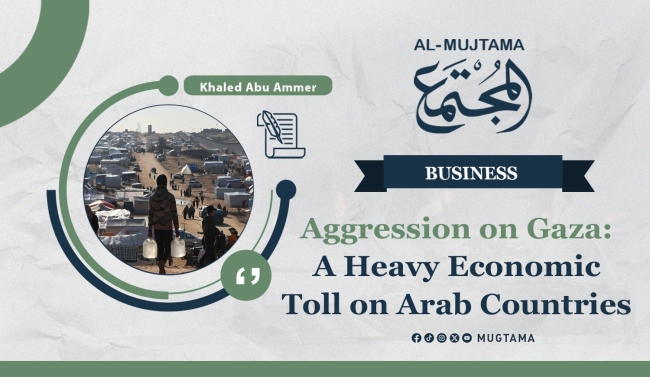Aggression on Gaza: A Heavy Economic Toll on Arab Countries
The Israeli aggression on the Gaza Strip has cast a shadow on the region's economies, particularly those of Arab countries, which have been negatively affected. This is evident in national and local output indicators, as well as in metrics of poverty, unemployment, and the rising cost of living.
The following report examines the direct and indirect economic costs incurred by Arab countries due to the aggression on Gaza, identifies the nations most impacted by this aggression, and assesses the time frame expected for these countries to recover from these effects.
Numerous international and regional reports have recently addressed the economic repercussions of the geopolitical changes brought about by the aggression in the region, directly affecting seven fronts targeted by the occupying state’s escalation, namely: Gaza, the West Bank, Lebanon, Syria, Iraq, Yemen, and Iran.
Gaza bore the brunt of the devastation, losing 16% of its original population as martyrs, injured, missing, or detained. Lebanon followed, enduring a destructive war in its southern regions, with its capital, Beirut, suffering significant damage to its infrastructure and essential facilities. The West Bank ranked third in terms of impact, followed by Syria, Yemen, Iraq, and finally, Iran.
Lebanon
Two recent reports by the International Monetary Fund and the World Bank examined the economic toll of Israeli aggression in the Middle East. They concluded that, apart from the Palestinian territories, where the war is ongoing, Lebanon ranks as the most economically affected Arab country due to the attacks that began on October 8, 2023, and lasted until the truce was signed on November 27, 2024.
The reports revealed that Lebanon has entered its worst economic crisis in decades, requiring up to two decades for recovery. Key sectors such as travel and tourism, which contribute one-fifth of the GDP, have been paralyzed, alongside agriculture, industry, and operations. Direct costs include the destruction of 37 villages and towns within a 3-kilometer radius along Lebanon's side of the Blue Line, damage to 40,000 housing units, and the displacement of 1.5 million people.
Statistics from "Statistics Lebanon," managed by Rabih Haber, estimate the losses during the 13-month aggression as follows:
- Total destroyed housing units: Approximately 11,000.
- Estimated damage value: $3.4 billion.
- Total losses: About $5.1 billion.
- GDP decline: 5.7%, bringing it to $14.5 billion.
- Agricultural sector losses: $124 million, with damage exceeding $1.1 billion.
- Trade sector losses: $178 million, with damage amounting to $1.7 billion.
- Housing sector damages: $2.8 billion, with losses estimated at $389 million.
- Tourism sector damages: $18 million, with losses reaching $1.1 billion.
- Environmental sector damages: $221 million, with losses at $214 million.
- Healthcare sector damages: $74 million, with losses of $338 million, including the destruction of 8 healthcare centers, the closure of 250 others, and the deaths of approximately 220 medical staff, with 300 others injured.
- Educational sector losses: $215 million, resulting from families sheltering in schools and educational facilities.
Egypt
Although Egypt was not a direct military target of Israeli attacks, it was economically impacted by geopolitical developments in the Red Sea region, which negatively affected the performance of the Suez Canal, one of Egypt's key foreign currency sources.
A New York Times report highlighted that Egypt, the Arab world's most populous country, had barely recovered from the rising costs of wheat and fuel imports, declining tourism revenues, and reduced investments when the Middle East war exacerbated inflation. Rising debt payments further diminished purchasing power.
Reduced shipping traffic through the Suez Canal—from the Mediterranean to the Red Sea—was evident in financial records. Canal revenues in the first eight months of 2024 averaged $862 million monthly, a 30% decline compared to the same period in 2023.
Egyptian President Abdel Fattah El-Sisi acknowledged $7 billion in economic losses. GDP growth slowed to 2.4% in the past year, down from 3.8% the previous year, due to Middle East crises, including the Gaza war.
Jordan
Jordan’s tourism sector was adversely affected by the Israeli aggression on Gaza, with tourism revenues for the first ten months of 2024 declining by $6.1 billion, a 4.4% drop compared to the same period in 2023.
Retail sectors, including clothing, electronics, and furniture, saw reduced sales, with pharmacies reporting a 20% decline in sales as consumers prioritized essential goods, according to the National Consumer Protection Association.
Syria
Since October 7, 2023, Syria has endured hundreds of Israeli attacks on military and civilian facilities under the pretext of targeting Iranian supply lines to Hezbollah.
Assessing the economic impact of the Gaza war on Syria is challenging due to internal developments, including the fall of Bashar Al-Assad’s regime and the establishment of a temporary governing body. However, Israel’s breach of the 1974 disengagement agreement and its subsequent occupation of several border villages in the Syrian Golan indicate ongoing repercussions.
Yemen
Yemen faced intense airstrikes by Israeli forces, alongside attacks by British and American naval forces. On January 10, airstrikes targeted oil storage facilities near Ras Isa Port in Hodeidah and the Haziz power station in Sana’a. Earlier raids primarily struck civilian facilities and infrastructure.
As Yemen remains a key supporter of Gaza in resisting Israeli aggression, the precise economic toll is difficult to quantify. However, Israel’s focus on oil, energy, ports, and fisheries—critical components of Yemen’s economy—has led to significant disruptions, including the shutdown of several airports.
-------------------------------------------------------------


